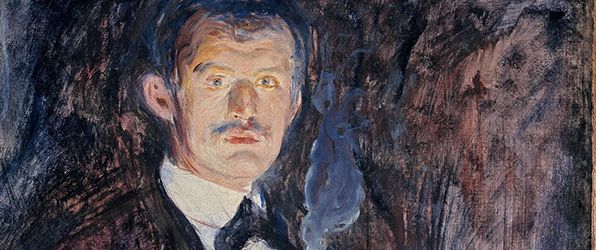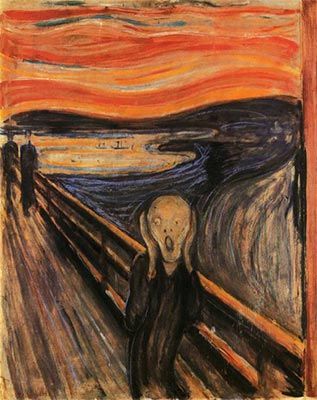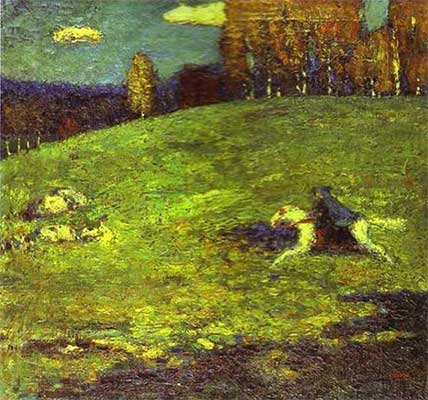Summary of Expressionism
Expressionism emerged simultaneously in various cities across Germany as a response to a widespread anxiety about humanity's increasingly discordant relationship with the world and accompanying lost feelings of authenticity and spirituality. In part a reaction against Impressionism and academic art, Expressionism was inspired most heavily by the Symbolist currents in late-19th-century art. Vincent van Gogh, Edvard Munch, and James Ensor proved particularly influential to the Expressionists, encouraging the distortion of form and the deployment of strong colors to convey a variety of anxieties and yearnings.
The classic phase of the Expressionist movement lasted from approximately 1905 to 1920 and spread throughout Europe. Its example would later powerfully inform many individuals and groups such as: Abstract Expressionism, Neo-Expressionism, and The School of London.
Key Ideas & Accomplishments
- The arrival of Expressionism announced new standards in the creation and judgment of art. Art was now meant to come forth from within the artist, rather than from a depiction of the external visual world, and the standard for assessing the quality of a work of art became the character of the artist's feelings rather than an analysis of the composition.
- Expressionist artists often employed swirling, swaying, and exaggeratedly executed brushstrokes in the depiction of their subjects. These techniques were meant to convey the turgid emotional state of the artist reacting to the anxieties of the modern world.
- Through their confrontation with the urban world of the early-20th century, Expressionist artists developed a powerful mode of social criticism in their serpentine figural renderings and bold colors. Their representations of the modern city included alienated individuals - a psychological by-product of recent urbanization - as well as prostitutes, who were used to comment on capitalism's role in the emotional distancing of individuals within cities.
Overview of Expressionism

On a walk he took with two friends at sunset, Edvard Munch described how "suddenly, the sky turned as red as blood .. Tongues of fire and blood stretched over the bluish black fjord. My friends went on walking, while I lagged behind, shivering with fear. Then I heard the enormous, infinite scream of nature." Expressed in his painting The Scream (1893), his emphasis upon intense inner experience set the path for Expressionism, defined by Ernst Kirchner as mirroring "the sensations of a man of our time."
Important Art and Artists of Expressionism
The Scream (1893)
Throughout his artistic career, Munch focused on scenes of death, agony, and anxiety in distorted and emotionally charged portraits, all themes and styles that would be adopted by the Expressionists. Here, in Munch's most famous painting, he depicts the battle between the individual and society. The setting of The Scream was suggested to the artist while walking along a bridge overlooking Oslo; as Munch recalls, "the sky turned as red as blood. I stopped and leaned against the fence...shivering with fear. Then I heard the enormous, infinite scream of nature." Although Munch did not observe the scene as rendered in his painting, The Scream evokes the jolting emotion of the encounter and exhibits a general anxiety toward the tangible world. The representation of the artist's emotional response to a scene would form the basis of the Expressionists' artistic interpretations. The theme of individual alienation, as represented in this image would persist throughout the 20th century, captivating Expressionist artists as a central feature of modern life.
Der Blaue Reiter (1903)
This breakthrough canvas is a deceptively simple image - a lone rider racing across a landscape - yet it represents a decisive moment in Kandinsky's developing pictorial language. Here, the sun-dappled hillside reveals a keen interest in contrasts of light and dark as well as movement and stillness, all major themes throughout his oeuvre. Constituting a link between Post-Impressionism and the burgeoning Expressionist movements, Kandinsky's canvas became the emblem of the expressive possibilities embraced by the Munich avant-garde. This is the eponymous work from which the collective derived its name in 1911.
Conrat (1909)
The esteemed art historians Hans Tietze and Erica Tietze-Conrat commissioned this portrait by Kokoschka for their art collection. The colorful background and concentrated gestures of the figures represent the couple as "closed personalities so full of tension," as the artist once called them. As in many of his portraits, Kokoschka focuses on the inner drama of his subjects, here, using the couple's nervous hands as a focal point of their anxiety. His rendering depicts the way the artist perceived the couple's psyche, not necessarily their physical, naturalistic appearances. Kokoschka's emotional representation is emblematic of the Expressionist style. The swirling, abstract colors that obscure the background and emerge around them are characteristic of Kokoschka's frenetic, depthless renderings of space throughout his oeuvre.



কোন মন্তব্য নেই:
একটি মন্তব্য পোস্ট করুন